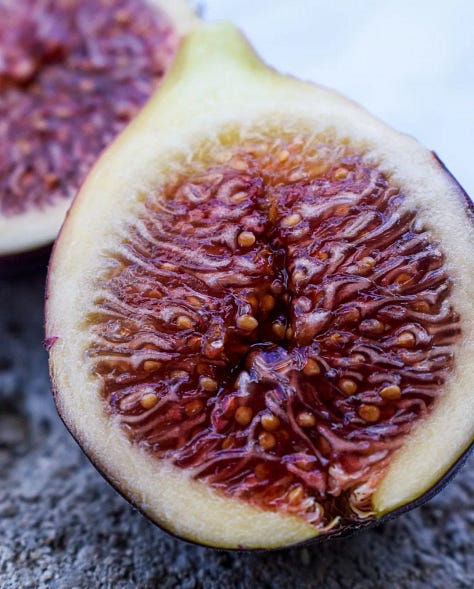
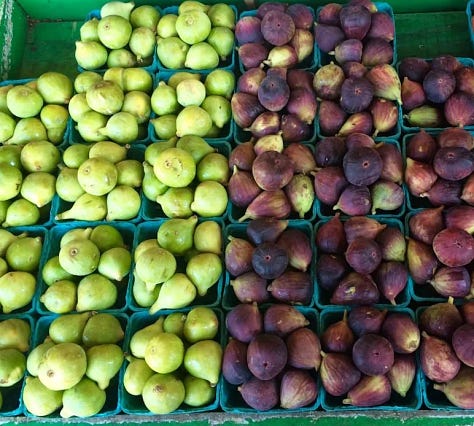
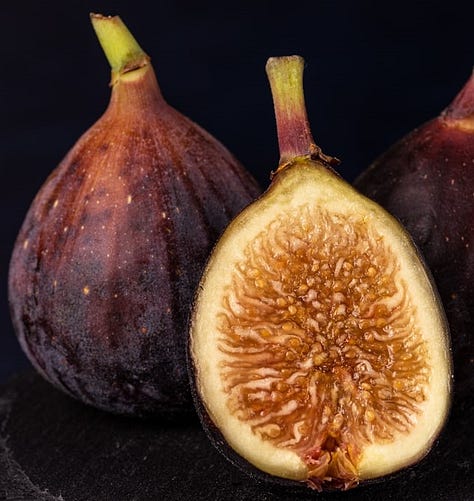
Figs taste like Fig Newtons of course— said no fig collector ever! Figs are surprisingly complex in their flavor profile and can offer a unique eating experience that is hard to classify. If you’ve only had the mediocre fig offerings from a grocery store then you are in for a surprise!
“But wait, aren’t there only two types of figs, light and dark?” you ask. Au contraire, my dear reader! There are hundreds of cultivars, if not thousands, and many flavors to be had in figs, everything from cotton candy sugar to caramelly dates to ripe musky melons to jammy strawberries & cherries to berry punches… Well, you get the picture, they’re all in there.
As a fig eater, it’s the flavor that brings joy. Flavor cannot be underrated, as it is what delights the taste buds and makes our cells sing & dance. It is what determines the choice for what I grow.
Don’t get me wrong, a fig tastes like a fig, just like wine tastes like wine. But as with wine, there are variations with figs that bring a variety of flavors to the table. Certain fig bloggers and sellers seem to have their own version of fig flavor groups, including this writer here as you will find. So what are they and why do they matter? Join me on this quest to unravel the enigma that is the taste of figs!
*Cue inspirational-quest music! 🧙♂️
Ahem… Did that only go well in my head? Okay, moving on… 🤓
Why do flavor groupings matter?
Describing the flavor of figs has been a long-debated subject in the Fig-o-sphere, sometimes even quite heated. Many sellers have been accused of overhyping taste with flowery descriptions to get higher prices. Opinions run high amongst collectors for how to accurately describe taste — some can taste flavor notes & nuances and others can’t. To those who can’t, these descriptions can seem ridiculous. And to those who can, the disgruntled can seem unreasonable.
It is true, a lot of it is highly subjective. One person’s “bubble gum” is another person's “sugar with something extra” they can’t quite place. I don't know about you, but I like more description than just “sweet” though when picking out a variety to grow.
As a collector, flavor is an important component for distinguishing varieties and describing them to others. Flavor comparisons are the only way to describe something to someone who can’t taste it. You may not have tasted an Adriatic fig, but if you’ve ever had a spoonful of strawberry jam, you have a good idea of what to expect.
Having flavor groupings can help the grower better choose varieties so that they don’t have too much overlap in taste. While there is variety in flavor, those of the same taste profile can start to blend together and become hard to tell apart unless eaten side by side. Too much monotony in flavor can make the experience less enjoyable in my opinion. Choosing a few varieties from each flavor group can bring a more diverse collection and help it not go overboard.
What can affect flavor?
Ripeness plays a huge role in the overall flavor quality. Most unripe figs can have a sort of bitter or plain cucumber-type taste to them. As the fig ripens though, this can transform into a mild, underlying grassy, earthy, herbal type hint or into a ripe melon presence in the flavor that is very pleasant to discerning palates. The key is to have a properly ripened fig for the flavors and sugars to develop.
The skin can also affect flavor. This is where you can get certain notes of bitterness, tannic spices, earthiness, but also sweetness or even coconuty-ness. Some prefer to peel the skin, but most often it is eaten with the pulp and contributes to the overall flavor.
Environmental factors can affect flavor and fruit characteristics, such as water, sunlight or lack thereof, etc. Excessive rain or overwatering can cause fig fruits to overswell with water thereby diluting the sugars and flavor leading to a bland-tasting fig. Too much heat and sunlight can cause early softening before it has fully ripened, which can also lead to spoilage and fermentation-type flavors. Ripening in colder weather can make for a less sweet fig or for more bitterness to come out in the skin.
Other factors of terroir — the soil makeup, soil amendments & fertilizers, and surrounding plants — have a bearing on flavor. Some people will find well-established fig trees in their area, usually Hardy Chicago or Celeste, and feel that they are a new variant because those figs have flavor nuances unique to the local terroir in which they’ve been grown. They aren't new variants, it is just the effect the local land can have on flavor.
Plant health and age also affect flavor. Healthier plants tend to have higher Brix levels which leads to sweeter fruit. Disease or pests can negatively impact flavor as well and cause spoilage. First fruits are notorious for not tasting as good as fruits from mature trees.
Caprification or pollination of figs has a strong impact on flavor. Caprification can turn a light berry-tasting fig into a more intense berry fig. It also adds a certain acidity or brightness to the flavor making it more complex. Occasionally, caprification has a negative effect on flavor as sometimes pollen is contaminated with yeasts, fungi, or bacteria which can lead to off-flavors or spoiling.
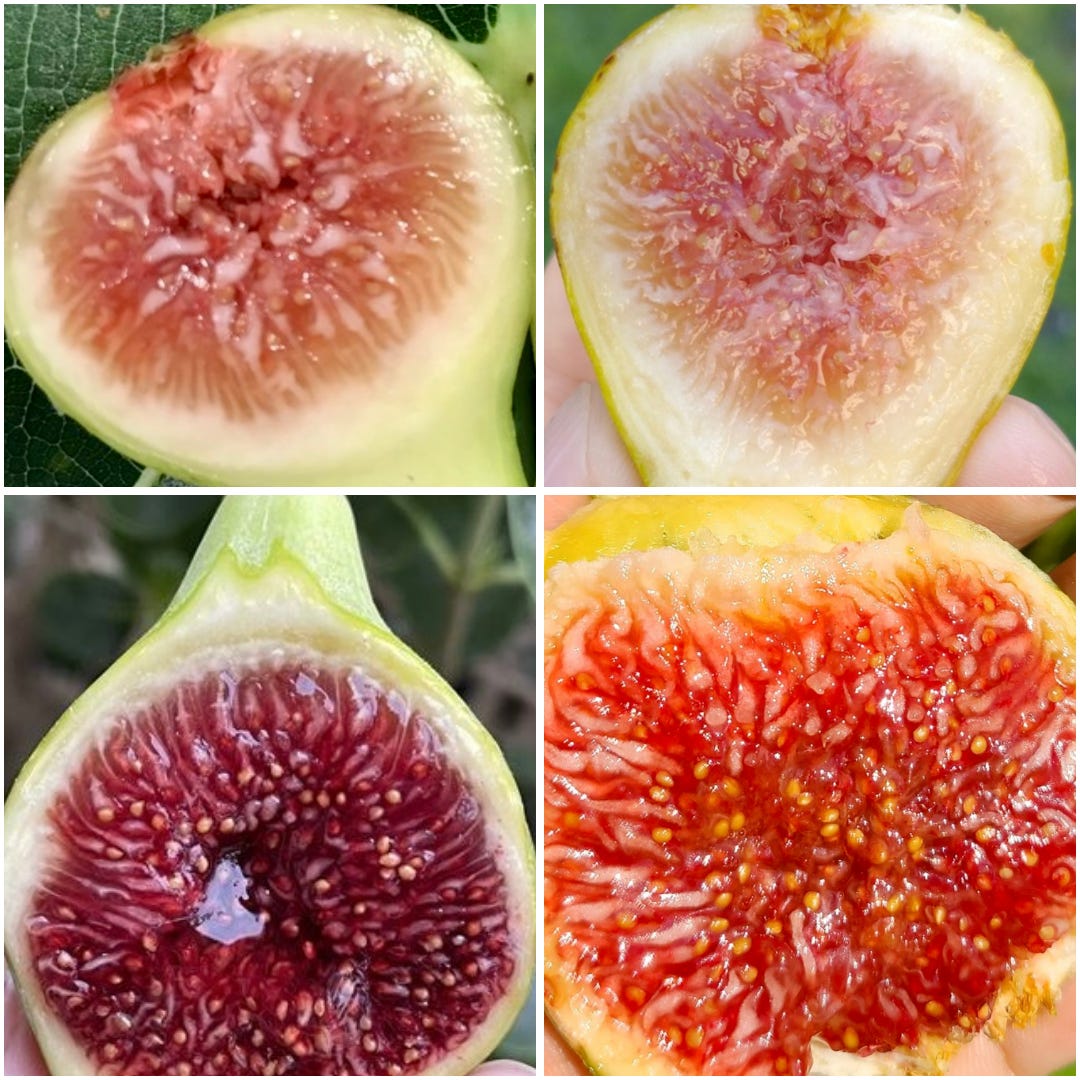
Flavor group disclaimers
There is a definite overlap between categories and some categories are combined into one. The catch is trying to get a flavor grouping that accurately holds and makes room for these flavors without being so complicated that no one can remember it. Let’s be real, no one wants to consult a list of 31+ flavor possibilities when classifying their fig collection.
Many are influenced by nuances or flavor hints that are present in varieties. However, these are not predominate flavors, they are not always present, and detection of them can vary depending on the person tasting it or the growing conditions. A nuance, though noted and appreciated, is not a category. So the flavor groupings listed in this article are based on the prevailing main flavor alone as a broader categorization for simplicity.
Oftentimes, the skin color with the pulp color can be an indication of the type of flavor. For example, a fig with yellow pulp will not taste like a berry fig, and often an intensely red-fleshed fig will have a berry flavor… It also can be said color is not a reliable indicator of flavor.
Color differences in figs are not as variable as are the flavors if you look at close-up photos of fig pulp. Skin and pulp color together can give an idea of the expected taste but is not 100% reliable and so should not be the sole guideline of flavors. There will always be outlier varieties that don’t fit the expectation. Not to mention growing conditions causing certain types of color variation in some varieties.

Some flavor categories are used by others that actually represent a fig family more than the flavor itself. For example, Adriatic Berry is often used for light-skinned intense berry-tasting figs. But Adriatics usually have their own unique flavor nuances themselves. So to name an entire flavor category that includes varieties other than Adriatic family figs, which don’t have those specific flavors, seems inaccurate to me. I eliminate this as a flavor category name to allow for the varieties that don’t fit within the Adriatic family. Same with Bordeaux.
The final disclaimer, these are fresh figs. A fig is a fig. It’s a fresh fruit and it tastes like a fresh fruit. So even though comparisons are made to other common fruits, syrups, or candies, they are not those things. They do not taste exactly like those things nor have the same depth of flavor as the real deal. If you’re craving caramel— eat an actual caramel. A fig described with caramel flavors will never be close to that. The comparisons are to give an idea on flavor profiles alone to aid in describing how one fig variety is different from another since you cannot see it or taste it yourself.
So then, what are figs like?
The flavor that is often described as “fig” is a resinous type of flavor evocative of dates, persimmons, or raisins. Many people have eaten dried figs, and it’s this dried, cooked fruit flavor many associate as “fig” taste. But this flavor only lightly covers a small number of varieties and it is not really present in the same way in fresh figs. Figs are sweet fruits and have low acidity. Most figs taste like jam of other fruits to me, though some are more lighter and refreshing. Let’s break it down.
🥒 AROMA
The predominant scent in most figs is an herby, grassy, fresh cucumber-type aroma. This is the top note or the first scent you will experience with a fresh fig when you cut it open and smell it. It smells “fresh” like cucumber water.
👅 MOUTHFEEL
The skin can greatly affect mouthfeel with some skins being soft and tender, others being tough and coarse. Some varieties have a slight fuzziness from fine hairs present on the skin.
The pulp is always tender & squishy. It can be loose and juicy with syrup, sometimes but rarely stringy, thicker and jammy, or more dense, pasty, & sticky. The pastiness comes from starches present in the pulp and summertime heat will bring out the sugars in this.
Some varieties have more seeds than others. Cultivars with few seeds are more jelly like with a smooth consistency. The seedier figs add a little more crunch and texture and are like seeds in berry jams. Seeds can also impart a slightly nutty taste. Caprification makes seeds fertile and enhances them giving figs more crunch.
🥸 FLAVOR NUANCES & HINTS
The majority of figs will have a strong, dominant main taste, as indicated by the flavor categories. Accompanying these main flavors are base note nuances, often from the skin or inner wall that can be described as grassy, herbal, cucumber, earthy, resinous, chemical, bitter, spicy, sweet, or coconut. Sometimes these are noticed but often they do not stand out as much as the main flavor.
Noticed or not, these can lend a balance to the overall taste and enhance the main flavor. Some varieties have stronger base notes than others. Adriatic and Mount Etna family figs often have consistent base notes that make them recognizable as their type even if the main flavor varies a little.
Figs can also have other nuances giving complexity to the overall flavor. Oftentimes brightness is noted and can be described as acidic tasting flavors, such as passion fruit, pineapple, nectarine, or citrus. Sometimes tropical hints are noted. Other times the flavor can be elusive and hard to pinpoint to something specific. But the complexity makes a delicious-tasting fig.
💪 DOMINANT PULP FLAVORS
To make it as basic and oversimplified as possible, the most primary and dominant pulp flavors are Sugar, Fruity, and Berry. All figs will fall into one of these three. And I would say strawberry jam and ripe muskmelon are the most commonly encountered flavors. Done!
For your average grower, you can probably stop here and go do something fertilizery or something…
…You’re not the average grower though, are you? 😉 Same here, friend, let’s continue.
🍭 Sugar represents those flavors that go from white sugar and grassy sugar cane to sugar browning type resinous flavors associated with vanilla, nuts, syrups, and dates. These are very mild flavors most often associated with brown fruits with creamy flesh or brown dried fruits with caramelized sugars.
Figs in this class can be very refreshing and are a nice change from berry figs. At its worst, these can be plain & insipid, perhaps like watery oatmeal with a weird aftertaste — again, growing conditions at play here. But, often these have pleasant, mild flavors that offer a nice balance to the other categories. Not always much flavor, but refreshing.
🍉 Fruity are those flavors that taste like melon, most often a ripe muskmelon. This also includes varieties with the fruity flavors of stone fruits and other tree fruits like peaches, nectarines, apricots, apples, and plums. Occasionally, tropical notes are detected, such as banana, pineapple, or mango. Figs in this group are medium in flavor intensity and are associated with yellow or orange-fleshed fruits.
🍓 Berry is the largest classification in my opinion and is the most intense flavor category associated with red and purple-fleshed fruits. Strawberry is probably the most common flavor and is present in many varieties, with mixed berry as a close 2nd. Raspberry is also a definite flavor that is experienced. Black or red cherry, blueberry, and purple grape are also often mentioned by growers.
Some varieties in this category have a terrific complexity that is reminiscent of childhood red or berry fruit punch drinks— juicy and refreshing with flavor intensity but hard to break out the specific fruits being tasted.
Another way of looking at it is by flavor intensity and these categories could also be respectively listed as:
Mild
Medium
Intense
They also could be listed by the representative fruit color flavors of:
Brown fruits
Yellow-orange fruits
Red-purple fruits
The flavor groupings I use
🍭 SUGAR 🥥🍪
— Agave Sugar: These are flavors reminiscent of agave syrup. They can be described as sweet and slightly earthy. It is a very mellow taste that is not overpowering and is often compared to a neutral honey with subtle hints of vanilla and caramel. Very mild with fruity or floral undertones. This is your most basic type of flavor and may be like sugar cane, white sugar, plain cotton candy, or fresh yellow dates. These figs can be very refreshing.
— Date Sugar: These are flavors likened to date sugar or date syrup and have a stronger, deeper sugar browning taste than the Agave category. These are fruity, deep sugar flavors, with nuances that go to caramelly dates or may hit into dried, cooked fruits with their browned sugars. Sometimes fresher, lighter notes of jujube or fresh date are present. Occasionally spice or bitter browned notes are detected.
🍉🍌🍍 FRUITY 🥭🍏🍑
— Honey Melon: This is a flavor that tastes of a rich, ripe muskmelon. These can get tropical or berry flavor hints but the dominant taste is melon. The richness and color of these figs often cause them to be described as honey figs. But the actual flavor is not honey at all which is why I am not using it alone here. It is not a honey fig, it is a melon fig. (“Honey” is used here to indicate the richness of nectar-type flavor, not to indicate color or literal flavor.)
— Peach Fruit-Berry: These are varieties that have a taste of stone fruits like peaches, nectarines, apricots, or plums. Some of these varieties also get a bit of berry flavor, but the berry is usually milder with stone fruit or other miscellaneous fruity flavor being the dominant taste. These are not deep enough to be a true berry fig. Caprification may turn some of these varieties into a stronger berry-tasting fig.
🍓🫐 BERRY 🍒🍇
— Honey Berry: These are varieties that have a less intense berry flavor than others in the Berry grouping. It is as if you smooshed a sugar or melon fig together with an intense berry fig and this is the combined result. They are like a mild-tasting sugar-dipped strawberry. Some may have a slight melon taste, others less so. They can be richer tasting, nectary, and a fruity berry, with light berries being the dominant taste. Caprification may turn some of these into a more intense Red Berry fig.
— Red Berry: This encompasses those flavors of sweet, intensely flavored, red fruits such as strawberries, raspberries, cherries, fruit punch, etc. Red fruits are often associated with sweetness and tanginess.
Strawberry jam is a standout flavor in this group, others in here also evoke thoughts of jam. They allow for that citrus brightness coming through from the lemon juice added in jam making as well as the flavor depth of jam.
Red fruit punch is red jam + something extra. It’s a taste that is elusive & hard to define but has a sweet and tangy complexity that tastes of red fruits. This is my favorite flavor and is often more refreshing than the jammier Adriatics to me. 😍
— Dark Berry: This includes flavors of dark fruits such as black mulberries, blueberries, black cherries, black raspberries, blackberries, and purple grapes. This category represents those deep berry essences of dark berry jams. This also includes dark berry punches that taste of mixed berries with undefinable complexity.
—Tart Berry: This represents those special figs that especially have that sweet-tart taste. This is not your cloyingly sweet berry jam or punch. They are often specific, definable tart berries but with sufficient sweetness that they are enjoyable to eat fresh. This includes red mulberry, sour cherry, tart raspberry, cranberry, and possibly pomegranate. This could be considered a subcategory of one of the other Berry groups, and it’s not broken out on the flavor wheel. But enough varieties have a more tart taste that I decided to make it its own category so that I could note them in my variety library.
So that's it! Just eight categories. (At this time. 😏) They are subject to change and refinement as I taste more figs. After all the quest continues! (Cue music? No? Okay.)
Fig Flavor Wheel
This is version 127, slight exaggeration though it feels like it 😮💨, of my flavor wheel for figs. It is more comprehensive than the above list and gives a few representative varieties. Colors are an approximation and not exact. Cultivars next to each other do not necessarily taste exactly the same. The skin nuances of “spice, resin, and bitter” are picked up in some cultivars but not all. The degree of all skin notes varies by variety and are usually pretty mild. Hopefully, it gives a mental picture of how the flavor categories work and is handy to your fig journey!
Whelp, we’re at the end ☺️
Do you know what a fig tastes like now?? I hope so!
Defining fig flavors is not easy! There are other common lists out there and you may notice I did not use the same exact categories as they do. That is because after much reflection, I didn't think they captured the flavors with the accuracy I was looking for. I don’t think there is anything that can be perfectly accurate for every variety, but this gets the job done for me and I hope it helps you as well. As always, I recommend you to use whichever resonates the most with you. Definitely a lot of respect goes to those who started the journey of flavors before me!







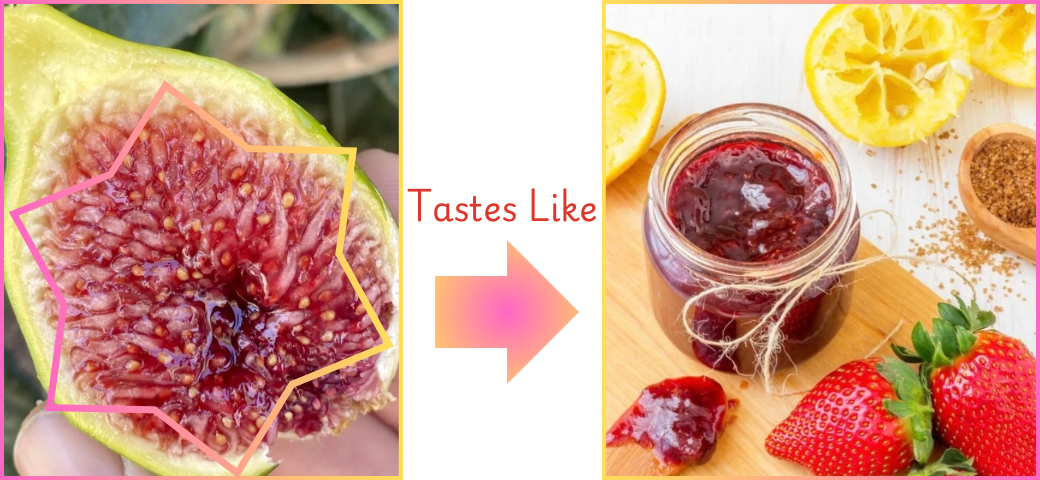
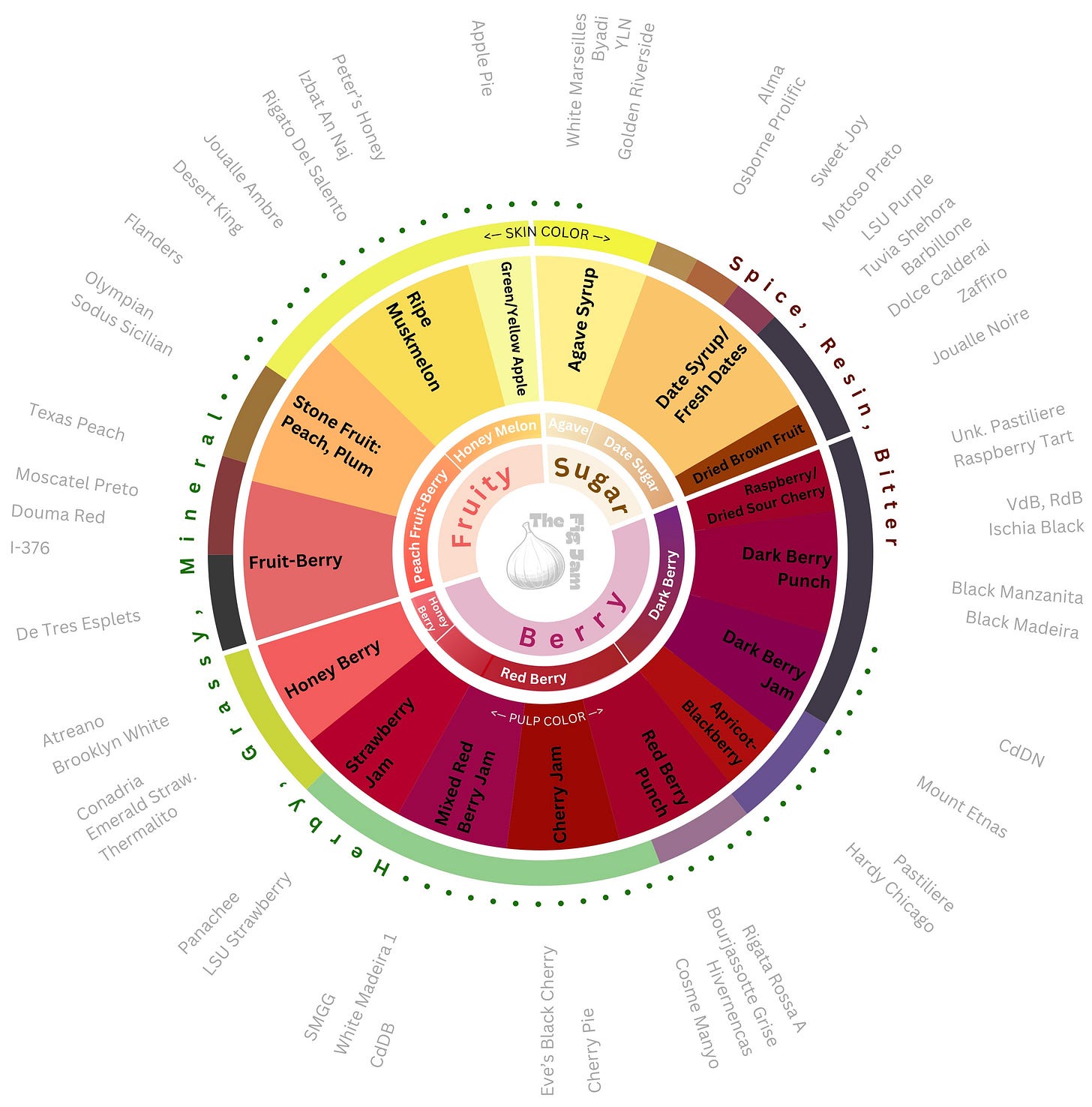
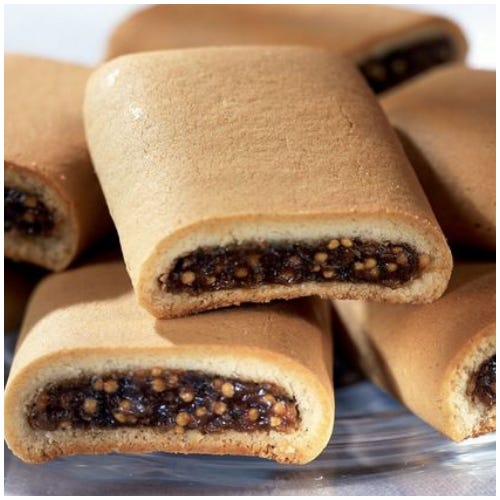

I loved your right up on this subject! I always thought we could use a flavor wheel , and barrow wine tasting terms for figs. If we fig people can use wine tasting terms in the same context… it would make sharing the traits of the fig much more easy. Example of a wine term we misused on the forum would be the word ( complex)…it seems to be used to mean when a flavor note can’t be distinguished easily. Other terms we haven’t used much yet would be rustic vs. elegant.
rustic wine would have fewer notes with less nuances than one described as having an elegant profile.